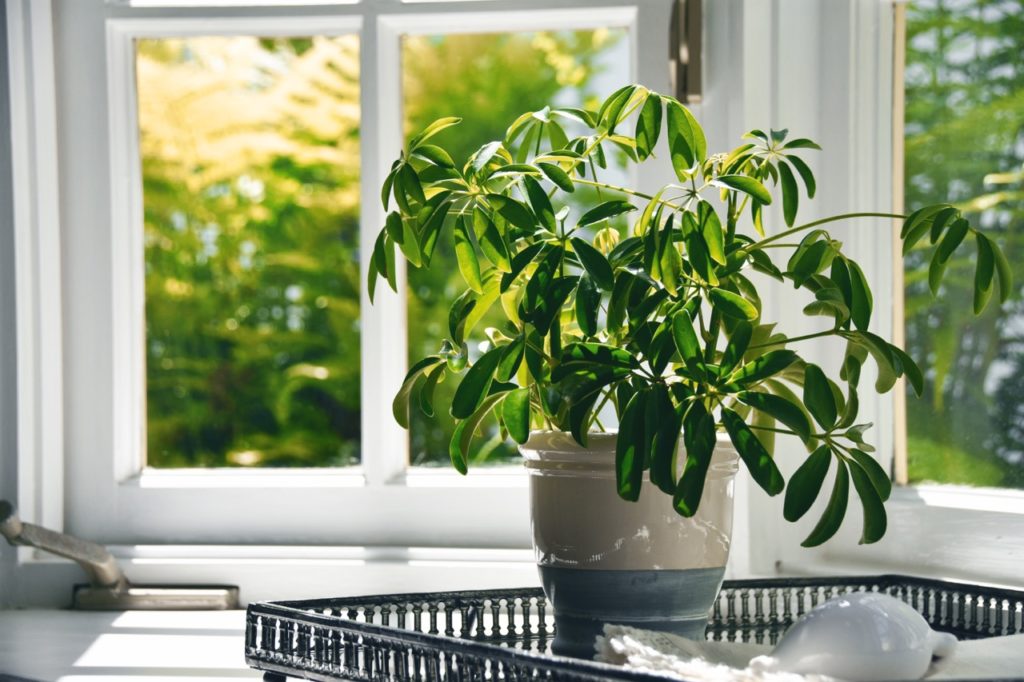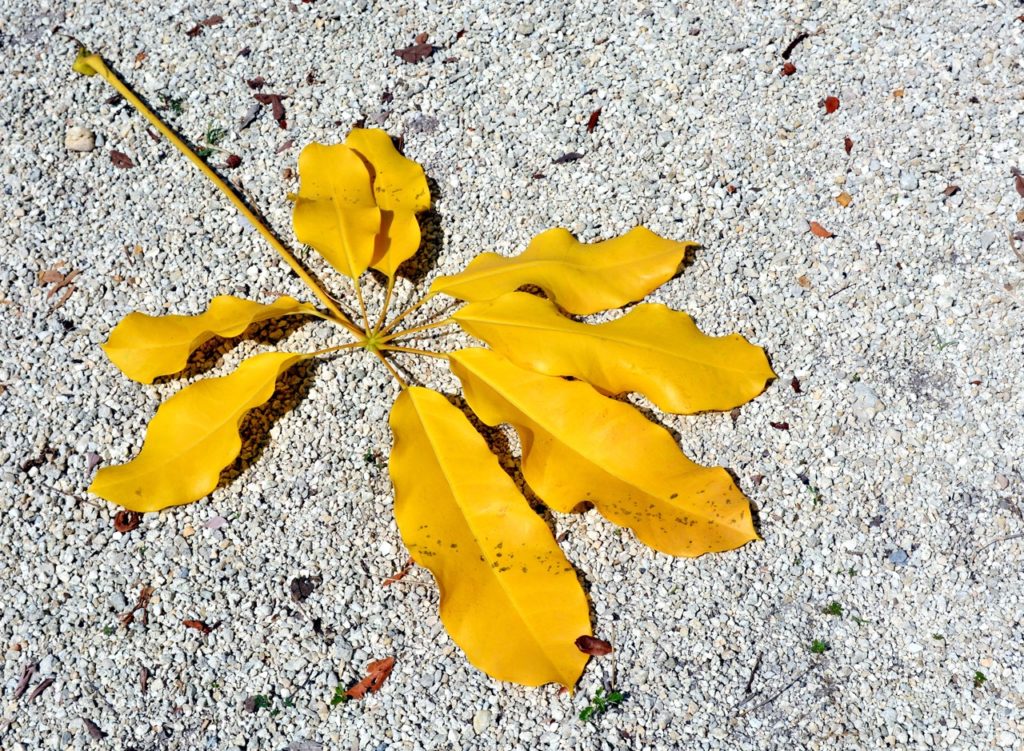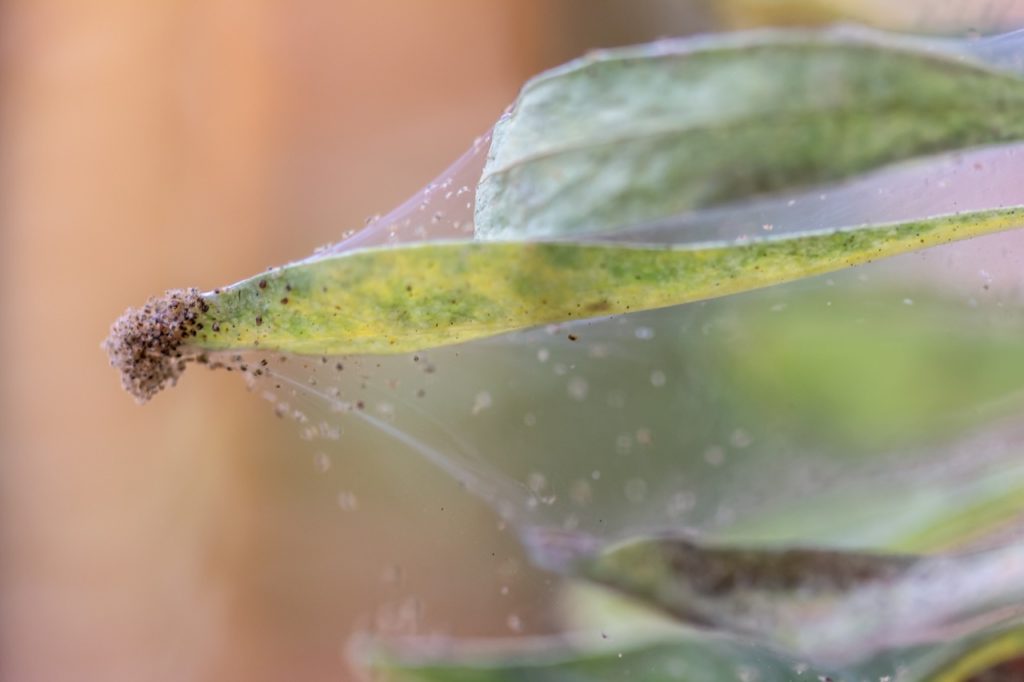HOUSEPLANTS > SCHEFFLERA
Reviewed By COLIN SKELLY

Colin is a Horticulturist and Horticultural Consultant with experience in a range of practical and managerial roles across heritage, commercial and public horticulture. He holds the Royal Horticultural Society’s Master of Horticulture award and has a particular interest in horticultural ecology and naturalistic planting for habitat and climate resilience.
IN THIS GUIDE
SCHEFFLERA GUIDES
Native to warmer regions of the globe, Schefflera are tropical evergreen plants that add a lively splash of colour to any home or garden they’re located in, all through the year.
Their main selling points are their broad-leaved foliage, which radiates out from the central stem in an umbrella-like fashion, giving them their moniker.
Although they do produce impressive blossoms in their natural habitat, you’re unlikely to reproduce similar results in Britain.
Indeed, their preference for warmer climes means that they’re most commonly grown as houseplants in this country.
Even dwarf varieties can reach up to 3m indoors, making them one of the larger shrubs available, but they’ll still fit comfortably inside most rooms and give them a burst of life and energy.
Overview
| Botanical Name | Schefflera arboricola |
| Common Name(s) | Umbrella Plant / Parasol Plant |
| Plant Type | Tropical houseplant |
| Native Area | South & South-East Asia; Australia |
| Hardiness Rating | H1C |
| Foliage | Evergreen |
| Flowers | White, pink or red tentacle-like flowers (rarely seen on indoor plants) |
| When To Plant | March-May |
| When To Prune | Whenever it appears leggy |
Sunlight
Preferred
Bright, Indirect Sunlight
Exposure
Sheltered
Size
Height
0.5-1M
Spread
0.1-0.5M
Bloom Time
Summer
Soil
Preferred
Loam or sand
Moisture
Moist but well-drained
pH
Acidic to neutral pH
A member of the Araliaceae family, the Schefflera genus is a tropical evergreen shrub or tree native to tropical climes but hugely popular in the UK.1The Editors of Encyclopaedia Britannica. (1998j, July 20). Schefflera | plant. Encyclopedia Britannica. Retrieved March 23, 2023, from https://www.britannica.com/plant/schefflera
The shelter-giving nature of its foliage has inspired its common name of the ‘Umbrella Plant’ or, more aptly in its native climate, the ‘Parasol Plant’.

However, smaller varieties of the species are commonly grown as houseplants.
Although this practice is relatively new in the Western world, it’s one that stretches back millennia in certain parts of Asia.
Common Varieties
Generally speaking, there are two common varieties of Umbrella Plant available in the UK.
Schefflera actinophylla is the original cultivar and can reach heights in excess of 20m when grown outdoors.

But as mentioned above, that rarely occurs in the UK due to the inclement climate on these shores.
Instead, its smaller counterpart (S. arboricola) is preferred as an attractive tropical houseplant.
This can reach 3m in height.
Where To Grow Schefflera
Schefflera need bright but indirect sunlight to flourish, so place them underneath a patio awning if growing outdoors and move them inside in the winter.
Direct sunlight is a no-no since it can cause the leaves to burn and brown.
They’re hardy enough to the elements otherwise, but need plenty of watering and will appreciate fertile soil which drains well but can still retain moisture.

A slightly acidic mixture (sandy loam which resembles their natural jungle environment) is ideal.
They require similar conditions indoors, so ideally you’ll find a spot for them near an eastern or northern-facing window.
A sheer curtain can help to deflect some of the harshest rays of the sun.
Humidity is appreciated but not essential, so a bathroom location can work well if available.
Schefflera Houseplant Care
Watering
Schefflera like their soil to dry out completely before rewatering.
For that reason, it’s advisable to check the soil is entirely free from moisture (inserting a finger into the top 2cm will do the trick) before watering them.

When doing so, try to avoid getting the leaves wet and instead concentrate on the soil itself.
Give it a thorough soaking so that the water runs freely from the drainage holes in the pot.
Pruning
Strictly speaking, schefflera plants do not require pruning at all.
However, you might find that your specimen is becoming leggy, overgrown or unkempt, especially if it’s not receiving an adequate amount of sunlight.

When pruning, strip back unsightly parts of the plant down to 2-3 leaf nodes above their stem to retain its shape.
You’ll find that the plant will reward your efforts by redoubling on its own to achieve a fuller and more lustrous look in no time at all.
“I find that pruning out straggly stems of Schefflera is key to keeping an attractive, compact shape to the plant when used as a houseplant,” shares Master Horticulturist Colin Skelly.
“In any other than the most perfect location, there is a tendency for them to reach a bit for the light in the home. They will respond with vigorous growth, which provides a lusher, more shapely appearance.”
Soil & Feeding
Fertile soil is essential to ensure your Schefflera thrives, whether it’s planted indoors or outdoors.
There’s no need to add stones to increase drainage, but a compost with around 1/3 perlite to 2 parts soil in its composition is helpful.

Again, fertiliser is not 100% necessary in order to maintain a healthy and happy plant, but it certainly won’t hurt.
As hungry plants, they’ll benefit from a monthly application of liquid fertiliser in spring and summer and a bimonthly feed in winter.
Staking
In the vast majority of cases, staking your umbrella plant is not required, since it’s hardy and strong enough on its own.
If you find that it’s beginning to droop under its own weight or become unwieldy, pruning it is a better course of action than staking.
Repotting
Schefflera plants must be repotted when they have exhausted the space inside their existing container.
You can inhibit their growth by waiting until the last moment when roots begin to appear through the drainage holes or curl up around the sides of the pot.
When repotting, remove the plant from the pot and gently tease apart the roots, soaking them in water to aid with the process if necessary.

Place the root ball in a larger pot which has between 2-3cm of space on all sides of it, then fill it in with a 2/3 soil and 1/3 perlite mixture.
Don’t compact the compost too much, then thoroughly water once more.
You may be tempted to upgrade your plant to a much larger pot immediately to save repotting at a later date.
This is not advisable, however, since it will inhibit the growth of your schefflera and contribute to a less attractive specimen.
Propagating
Propagating umbrella plants from cuttings is a tricky business that is likely to bear mixed results.
To attempt it, take a cutting of a healthy stem about 15cm in length, making the incision at a 45° angle.
Strip away all but the upper set of leaves (around 5-6 in total), then dip the cut end into a rooting hormone mixture.
Plant the cutting into potting soil, submerging the tip deeply enough to allow it to stand up of its own accord.

Within around a month, new roots should have formed, and you can check whether they have by lightly tugging on the stem.
If there is no resistance at all, the propagation has not worked.
Common Problems
Although hardy creatures, scheffleras do suffer from damage, disease and pests at times.
Here are some of the most commonly observed tell-tale signs, what they mean and how to counteract them.
Leaves Curling
If you find your leaves are curling or drooping, it’s most likely a sign that you’re not watering your plant enough.
Remember to completely soak the soil once it has become dried out to the point that excess water runs freely from the bottom of the pot.
Drooping Stems
Like curling leaves, drooping stems are also indicative of a thirsty plant.
Follow the instructions above to bring some robustness back into your schefflera.
Dropping Leaves
Your schefflera plant may lose leaves for a number of reasons.
If the leaf drops are accompanied by curling leaves or drooping stems, you’re probably not watering it enough; if they’re not, you may be watering it too much!

In either case, take the appropriate action to see if it helps.
Alternatively, leaf drops can occur if the plant is located in too cold an environment or isn’t receiving enough light.
Move it to a warmer, brighter area to test if that is the cause of the issue.
Dark Or Discoloured Leaves
If the foliage of your schefflera is browning, light or otherwise discoloured, it could mean it’s being burned by the sun.
Place a shade nearby to protect it from the brightest rays.

On the other hand, dark or discoloured leaves could be symptomatic of leaf spot.
Treat the plant with a copper-based spray, then fertilise it more regularly to restore optimum nutrient levels.
Deposits, Webs Or Growths On Leaves
Sticky white residue on your plant points to the presence of aphids, which can be repelled with an insecticidal soap aimed at houseplants.
If the growth is darker and more powdery in texture, it might be sooty mould, which is a by-product of an aphid infestation.

Wipe the leaves clean and tackle the root cause.
Meanwhile, webbing material on the foliage or stems is a sure sign that spider mites are attacking your plant.
Use neem oil or another horticultural product (preferably an organic one) to get rid.
FAQs
What Are The Signs Of An Overwatered Umbrella Plant?
There’s such a thing as too much water for many houseplants, including schefflera.

If it’s losing leaves without drooping or drying out, or if it’s showing blackness or signs of decay on either its foliage or its roots, it’s probably struggling in too much water.
Can You Propagate An Umbrella Plant In Water?
While it is possible to propagate an umbrella plant in water, doing so will deprive it of many of the vital nutrients and minerals it needs to survive and thrive.
As such, it’s highly advisable to plant your shefflera cutting in potting soil instead.
How Fast Do They Grow?
Schefflera is fairly fast-growing, but you can slow them down by delaying repotting them until the last possible opportunity.
How Can I Make An Umbrella Plant Bushy?
Umbrella plants are naturally bushy specimens, so you shouldn’t have to do too much to encourage that behaviour.

However, pruning it to remove overgrown stems and leaves can reinvigorate the plant and make it fuller and more pleasing to the eye.
References
- 1The Editors of Encyclopaedia Britannica. (1998j, July 20). Schefflera | plant. Encyclopedia Britannica. Retrieved March 23, 2023, from https://www.britannica.com/plant/schefflera


